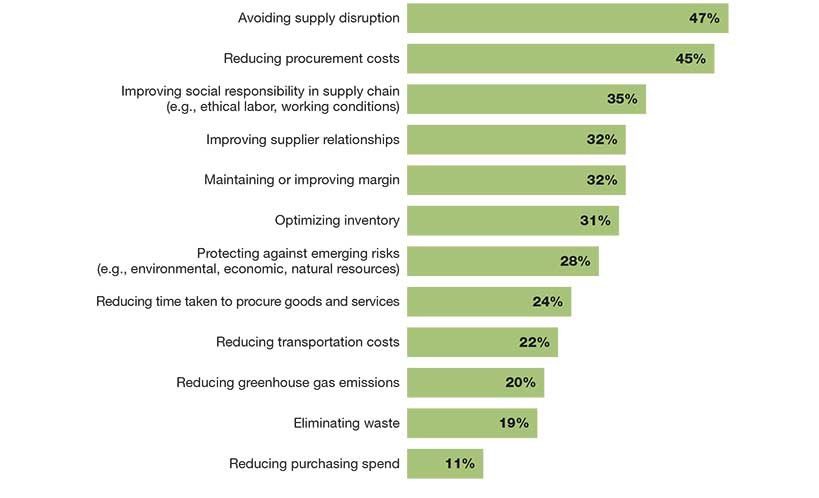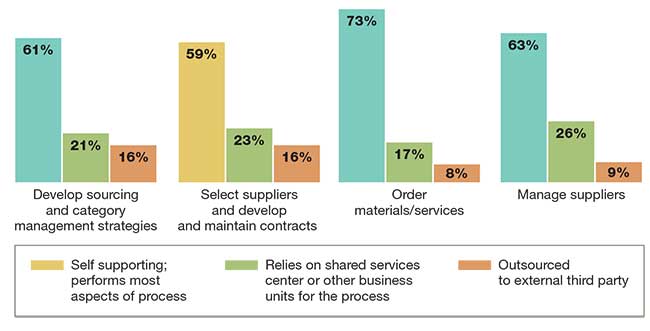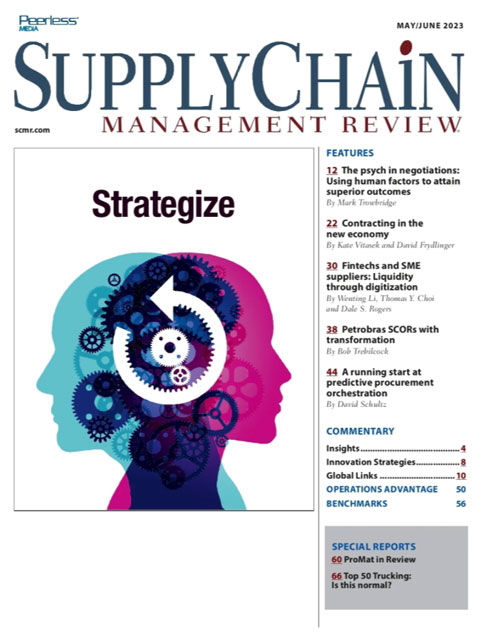Sorry, but your login has failed. Please recheck your login information and resubmit. If your subscription has expired, renew here.
May-June 2023
If you were dropped onto this planet and landed at McCormick Place in the heart of Chicago in the middle of March, you would probably conclude that planet Earth had been overrun by robots. Everywhere you turned on the ProMat conference floor, there was a robot lifting something, putting something away, or carrying something to another location. But, despite a conference hall overrun by technology, the on-the-ground reality is a bit different. Not so long ago, commercial real estate firm Prologis estimated the number of facilities with any type of automation at about 10%. But that is changing—quickly. A recent report from JLL found that one-in-two… Browse this issue archive.Need Help? Contact customer service 847-559-7581 More options
Supply chain professionals have long known that sustainability must be a key piece of their strategy. After the last three years of disruptions, shortages, and instability, the capacity for supply chains to endure is even more important. Beyond addressing disruptions, sustainability considers the protection of natural resources, the equitable treatment of workers, and community development beyond the enterprise.
An organization’s procurement efforts should touch on all the components of sustainability. Sustainable procurement includes weighing the environmental, social, and ethical factors in the selection of suppliers and purchasing of products. At the same time, it offers benefits such as efficiency, speed, and risk mitigation.
Take a look at the related infographic from APQC: Sustainability from the inside out
Figure 1: Extent to which procurement processes and systems have changed over the last five years

Source: APQC
To determine whether organizations’ procurement functions have kept up with the needs of sustainability, APQC collected data from 1,181 global respondents on their organization’s procurement processes. The results indicate that procurement processes and systems have evolved considerably over the last five years. As shown in Figure 1, the majority of procurement professionals have seen their organizations’ procurement processes and systems change to a moderate or significant extent.
Nearly one-third of the research participants say that their processes and systems have changed significantly, and 9% have seen changes to the point that these are no longer recognizable. As part of these changes, organizations realize that procurement, and supplier relationships in particular, is key to their sustainability efforts.
Figure 2: Most important objectives for procurement

Source: APQC
Current objectives and goals
When considering the most important objectives for their procurement strategy, participants in APQC’s research indicate that sustainability has a solid foothold. As shown in Figure 2, three of the top objectives are related to sustainability. Two are related to environmental factors, and one is related to the social responsibility of procurement.
The third objective on the list, improving social responsibility, reveals the importance of procurement in upholding an organization’s standards and its reputation related to social factors. No company wants to be associated with negative labor practices and poor working conditions, and it is up to the procurement function to vet suppliers.
For environmental objectives, procurement can play a part in reducing greenhouse gas emissions by considering this factor when identifying new suppliers and when re-evaluating existing suppliers. Elements that staff can consider include distance from a supplier to the product destination, as well as the practices of suppliers’ logistics providers. Although not directly caused by the buying organization, emissions from logistics providers can make an impact on the organization’s overall sustainability results and reporting.
Similarly, procurement staff must consider how waste reduction efforts can make an impact on purchasing. Some organizations are moving to more circular supply chains, in which they adopt remanufacturing and regeneration of products as well as their recycling efforts. If some products or components can be repurposed for additional use, this enables the organization to save money by purchasing fewer new items from suppliers.
Within the top five objectives for procurement is improving supplier relationships, which underpin sustainability efforts. Strong relationships enable organizations to communicate their sustainability goals and work with suppliers to meet those goals in a mutually beneficial way.
Goals for procurement. In addition to having sustainability as part of their procurement objectives, many businesses have also set it as part of their goals for procurement. As shown in Figure 3, 14% of APQC’s research participants indicated sustainability as the top goal for their procurement team. This is behind more traditional goals of improving company profit and user experience. It is encouraging to see an increase in the percentage of organizations taking a more holistic view of procurement beyond driving cost savings.
Figure 3: Most important goal for procurement organization

Source: APQC
Similarly, organizations have sustainability as a top focus for supplier relationships. As shown in Figure 4, sustainability again ranks third.
Interestingly, more organizations focus their supplier relationships on sustainability than on price. This indicates a shift in how companies identify and select their supplier partners. This is also illustrated by the fact that more organizations focus their relationships on supplier capabilities than on price.
Figure 4: Primary area of focus for supplier relationships

Source: APQC
The top area companies focus on for their relationships is delivery and ensuring continuity of supply. Although delivery methods are connected with emissions reductions, organizations have not yet completely connected delivery with sustainability.
Factors in implementation
To ensure that its procurement function makes sustainability a priority, APQC recommends that an organization first align on any enterprise-wide sustainability strategy. All procurement efforts should be in line with the priorities set by the organization as a whole. This includes defining ownership of the sustainability effort. Within the supply chain, the procurement team may be the most logical choice for this ownership role.
Procurement structure. As part of a supply chain strategy for sustainability, the organization should consider the best structure for procurement. Both centralized and decentralized structures have benefits, especially when considering the type of materials and services a company purchases.
A centralized structure enables a company to take advantage of volume-buying benefits, as well as aggregate data for better supply chain visibility to inform end-to-end decision making. In fact, APQC’s research shows that 75% of organizations use a centralized procurement structure for purchasing direct materials and services. For indirect materials and services, the results are more evenly split, with 45% using a centralized structure and 55% using a decentralized structure. This may make more sense for the types of purchases in indirect procurement, as decentralization enables more local control and provides greater purchasing speed.
Business entity role. Organizations should also consider who performs procurement tasks when determining how to execute their sustainability efforts. As shown in Figure 5, most organizations surveyed by APQC perform their procurement processes in-house or rely on a shared services center.
Conducting procurement activities in-house, whether within the procurement entity or through another business unit, strengthens an organization’s ability to manage sustainability efforts. Internal teams are able to better align supplier diversity and risk assessment with organizational strategy when identifying potential partners and developing contracts. As the organization manages its existing suppliers, it can ensure that there is transparency in the relationship and that the companies work collaboratively to address any risks that may arise.
Maverick purchasing. A key aspect of deploying a sustainability strategy in procurement is to eliminate employee behaviors that can introduce risk, especially maverick purchasing, i.e., purchases of items where an existing purchasing contract is ignored by employees who bypass standard procedures to procure items individually. The amount of maverick buying that occurs within organizations has increased over the last three years. Prior to the pandemic, the median percentage of organizations’ total annual purchase value procured through maverick buying was 1.2%. In 2021 and 2022, however, the median amount increased to 1.8%. This is a crucial difference for an organization with $1 billion in annual purchase value, which would accumulate an additional $6 million in less-controlled maverick purchases.
Maverick buying increases the risk of doing business with a vendor that has not been vetted according to enterprise sustainability standards. Organizations can address purchases made outside of a contract by strengthening their procurement processes and providing employees with the information they need to make sustainable decisions in line with company policies.
Visibility and collaboration are essential
Adopting a greater focus on sustainability in procurement involves both a review of internal processes and strategic collaboration with suppliers. Organizations with experience in applying a process-first approach to business challenges have an advantage in this effort because they possess the kind of deep understanding of their business that is the starting point for any successful change.
Figure 5: Business entity role in procurement processes

Source: APQC
Another key element is visibility. Sustainable procurement requires collaboration with partners to ensure that the organization understands the practices and impact of its suppliers. In addition, collaboration can provide access to partner data that enables an end-to-end view of the supply chain. This level of visibility and collaborative relationship provides an opportunity for organizations and their suppliers to jointly target areas for improvement and develop plans that benefit both parties. These efforts are key to ensure the organization mitigates risks and adheres to its sustainability promises.
About APQC
APQC helps organizations work smarter, faster, and with greater confidence. It is the world’s foremost authority in benchmarking, best practices, process and performance improvement, and knowledge management. APQC’s unique structure as a member-based nonprofit makes it a differentiator in the marketplace. APQC partners with more than 500 member organizations worldwide in all industries. With more than 40 years of experience, APQC remains the world’s leader in transforming organizations. Visit us at apqc.org and learn how you can make best practices your practices.
SC
MR
Sorry, but your login has failed. Please recheck your login information and resubmit. If your subscription has expired, renew here.
May-June 2023
If you were dropped onto this planet and landed at McCormick Place in the heart of Chicago in the middle of March, you would probably conclude that planet Earth had been overrun by robots. Everywhere you turned on the… Browse this issue archive. Access your online digital edition. Download a PDF file of the May-June 2023 issue.Supply chain professionals have long known that sustainability must be a key piece of their strategy. After the last three years of disruptions, shortages, and instability, the capacity for supply chains to endure is even more important. Beyond addressing disruptions, sustainability considers the protection of natural resources, the equitable treatment of workers, and community development beyond the enterprise.
An organization’s procurement efforts should touch on all the components of sustainability. Sustainable procurement includes weighing the environmental, social, and ethical factors in the selection of suppliers and purchasing of products. At the same time, it offers benefits such as efficiency, speed, and risk mitigation.
Take a look at the related infographic from APQC: Sustainability from the inside out
Figure 1: Extent to which procurement processes and systems have changed over the last five years

Source: APQC
To determine whether organizations’ procurement functions have kept up with the needs of sustainability, APQC collected data from 1,181 global respondents on their organization’s procurement processes. The results indicate that procurement processes and systems have evolved considerably over the last five years. As shown in Figure 1, the majority of procurement professionals have seen their organizations’ procurement processes and systems change to a moderate or significant extent.
Nearly one-third of the research participants say that their processes and systems have changed significantly, and 9% have seen changes to the point that these are no longer recognizable. As part of these changes, organizations realize that procurement, and supplier relationships in particular, is key to their sustainability efforts.
Figure 2: Most important objectives for procurement

Source: APQC
Current objectives and goals
When considering the most important objectives for their procurement strategy, participants in APQC’s research indicate that sustainability has a solid foothold. As shown in Figure 2, three of the top objectives are related to sustainability. Two are related to environmental factors, and one is related to the social responsibility of procurement.
The third objective on the list, improving social responsibility, reveals the importance of procurement in upholding an organization’s standards and its reputation related to social factors. No company wants to be associated with negative labor practices and poor working conditions, and it is up to the procurement function to vet suppliers.
For environmental objectives, procurement can play a part in reducing greenhouse gas emissions by considering this factor when identifying new suppliers and when re-evaluating existing suppliers. Elements that staff can consider include distance from a supplier to the product destination, as well as the practices of suppliers’ logistics providers. Although not directly caused by the buying organization, emissions from logistics providers can make an impact on the organization’s overall sustainability results and reporting.
Similarly, procurement staff must consider how waste reduction efforts can make an impact on purchasing. Some organizations are moving to more circular supply chains, in which they adopt remanufacturing and regeneration of products as well as their recycling efforts. If some products or components can be repurposed for additional use, this enables the organization to save money by purchasing fewer new items from suppliers.
Within the top five objectives for procurement is improving supplier relationships, which underpin sustainability efforts. Strong relationships enable organizations to communicate their sustainability goals and work with suppliers to meet those goals in a mutually beneficial way.
Goals for procurement. In addition to having sustainability as part of their procurement objectives, many businesses have also set it as part of their goals for procurement. As shown in Figure 3, 14% of APQC’s research participants indicated sustainability as the top goal for their procurement team. This is behind more traditional goals of improving company profit and user experience. It is encouraging to see an increase in the percentage of organizations taking a more holistic view of procurement beyond driving cost savings.
Figure 3: Most important goal for procurement organization

Source: APQC
Similarly, organizations have sustainability as a top focus for supplier relationships. As shown in Figure 4, sustainability again ranks third.
Interestingly, more organizations focus their supplier relationships on sustainability than on price. This indicates a shift in how companies identify and select their supplier partners. This is also illustrated by the fact that more organizations focus their relationships on supplier capabilities than on price.
Figure 4: Primary area of focus for supplier relationships

Source: APQC
The top area companies focus on for their relationships is delivery and ensuring continuity of supply. Although delivery methods are connected with emissions reductions, organizations have not yet completely connected delivery with sustainability.
Factors in implementation
To ensure that its procurement function makes sustainability a priority, APQC recommends that an organization first align on any enterprise-wide sustainability strategy. All procurement efforts should be in line with the priorities set by the organization as a whole. This includes defining ownership of the sustainability effort. Within the supply chain, the procurement team may be the most logical choice for this ownership role.
Procurement structure. As part of a supply chain strategy for sustainability, the organization should consider the best structure for procurement. Both centralized and decentralized structures have benefits, especially when considering the type of materials and services a company purchases.
A centralized structure enables a company to take advantage of volume-buying benefits, as well as aggregate data for better supply chain visibility to inform end-to-end decision making. In fact, APQC’s research shows that 75% of organizations use a centralized procurement structure for purchasing direct materials and services. For indirect materials and services, the results are more evenly split, with 45% using a centralized structure and 55% using a decentralized structure. This may make more sense for the types of purchases in indirect procurement, as decentralization enables more local control and provides greater purchasing speed.
Business entity role. Organizations should also consider who performs procurement tasks when determining how to execute their sustainability efforts. As shown in Figure 5, most organizations surveyed by APQC perform their procurement processes in-house or rely on a shared services center.
Conducting procurement activities in-house, whether within the procurement entity or through another business unit, strengthens an organization’s ability to manage sustainability efforts. Internal teams are able to better align supplier diversity and risk assessment with organizational strategy when identifying potential partners and developing contracts. As the organization manages its existing suppliers, it can ensure that there is transparency in the relationship and that the companies work collaboratively to address any risks that may arise.
Maverick purchasing. A key aspect of deploying a sustainability strategy in procurement is to eliminate employee behaviors that can introduce risk, especially maverick purchasing, i.e., purchases of items where an existing purchasing contract is ignored by employees who bypass standard procedures to procure items individually. The amount of maverick buying that occurs within organizations has increased over the last three years. Prior to the pandemic, the median percentage of organizations’ total annual purchase value procured through maverick buying was 1.2%. In 2021 and 2022, however, the median amount increased to 1.8%. This is a crucial difference for an organization with $1 billion in annual purchase value, which would accumulate an additional $6 million in less-controlled maverick purchases.
Maverick buying increases the risk of doing business with a vendor that has not been vetted according to enterprise sustainability standards. Organizations can address purchases made outside of a contract by strengthening their procurement processes and providing employees with the information they need to make sustainable decisions in line with company policies.
Visibility and collaboration are essential
Adopting a greater focus on sustainability in procurement involves both a review of internal processes and strategic collaboration with suppliers. Organizations with experience in applying a process-first approach to business challenges have an advantage in this effort because they possess the kind of deep understanding of their business that is the starting point for any successful change.
Figure 5: Business entity role in procurement processes

Source: APQC
Another key element is visibility. Sustainable procurement requires collaboration with partners to ensure that the organization understands the practices and impact of its suppliers. In addition, collaboration can provide access to partner data that enables an end-to-end view of the supply chain. This level of visibility and collaborative relationship provides an opportunity for organizations and their suppliers to jointly target areas for improvement and develop plans that benefit both parties. These efforts are key to ensure the organization mitigates risks and adheres to its sustainability promises.
About APQC
APQC helps organizations work smarter, faster, and with greater confidence. It is the world’s foremost authority in benchmarking, best practices, process and performance improvement, and knowledge management. APQC’s unique structure as a member-based nonprofit makes it a differentiator in the marketplace. APQC partners with more than 500 member organizations worldwide in all industries. With more than 40 years of experience, APQC remains the world’s leader in transforming organizations. Visit us at apqc.org and learn how you can make best practices your practices.
SC
MR


More Sustainability
- Investor expectations influencing supply chain decision-making
- 40% of procurement leaders ignoring sustainability, study reveals
- How to Create Real Retailer-Brand Loyalty
- Rethinking Strategy for a Circular World
- Supply Chain Sustainability Pressures Persist
- The 10 Questions Supply Chain Managers Must Ask Before Engaging With a New Vendor
- More Sustainability
Latest Podcast

 Explore
Explore
Topics
Procurement & Sourcing News
- How S&OP provides the answer to in-demand products
- There is still work to do to achieve supply chain stability
- Blooming success: The vital role of S&OE in nurturing global supply chains
- How one small part held up shipments of thousands of autos
- Shining light on procurement’s dark purchases problem
- 40% of procurement leaders ignoring sustainability, study reveals
- More Procurement & Sourcing
Latest Procurement & Sourcing Resources

Subscribe

Supply Chain Management Review delivers the best industry content.

Editors’ Picks






